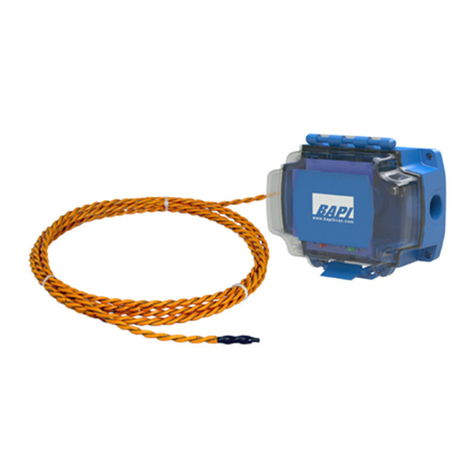
Termination and Troubleshooting
Water Leak Detector
BA/LDT Accessories
Building Automation Products, Inc., 750 North Royal Avenue, Gays Mills, WI 54631 USA
T
el:+1-608-735-4800 • Fax+1-608-735-4804 • E-mail:
[email protected] • Web:www
.bapihvac.com
Specications subject to change without notice.
rev. 04/28/17
26268_ins_LDT
6 of 6
Specications
Power: 24VAC/VDC +/- 10%
5 Amp Relays: 4 Watt/ 4 VA max
0.5 Amp Relays: 2 Watt/ 2 VA max
(not intended to switch a load)
Wiring: Flex Connector or Liquid Tight Fitting
Relays Up to 6 wires
Transmitter 2 wires for Power
Mounting: Lays in the pan or attached with a pan edge
hook with screws
Sensor:
Standard Single SS probe from bottom of BB with
adjustable depth screw from .063” to .84”
Optional Remote water sensor with depth screw with
adjustable depth from 1/16” to 1/2”
Optional Remote long line water sensor (Rope)
Detects water over the full length at
depths >0.125”. Note: 100 ft maximum
including non-sensing extension cable.
Detector Transmitter:
Alarm Contacts
LDT1: One SPST, 0.5A relay output, 10W max
LDT2: Two SPST, 0.5A relay outputs, 10W max
LDT3: One SPDT, 5A relay output
LDT4: Two SPDT, 5A relay outputs
SPST or SPDT, 30 VAC/DC max
Selectable as normally Energized or
De-energized
Indication 1 Green Power LED, 1 Red Alarm LED
Reset Action If latching, local push button or power
interrupt
Sensor Reaction
Responds to presence of water within 5
seconds
Termination: Terminal strip, 4-10 terminals, 12-24AWG
Agency: RoHS, UL94V-0, UV-rated in Enclosure
Set Up:
BB Sensor Adjustable depth from .063” to
.84” (≈1/16th” default)
Remote Sensor Adjustment depth from 1/16” to
1/2” (≈1/16th” default)
Latching Latching Version - Stays
Jumper
energized after water has dried up
Non-Latching Version (default) -
Alarm follows wet or dry surface
Supervision Supervised Version (default) -
Jumper De-energized when in alarm.
Note: Relay will drop out on
loss of power indicating a water
detection alarm.
Unsupervised Version -
Energized when in alarm.
Enclosure Ratings:
Remote Sensor Submersible, w/FEP plenum-
rated, waterproof cable
Rope Sensor Plenum rated
Transmitter BAPI-Box, NEMA 4
Ambient:
Remote Sensor -40 to 185ºF (-40 to 85ºC),
0 to 100%RH, Condensing
Transmitter (BB) -40 to 185ºF (-40 to 85ºC),
0 to 95%RH, Non-condensing
Rope Sensor 32 to 167ºF (0 to 75ºC),
0 to 95%RH, Non-condensing
Enclosure Materials:
Remote Sensor Aluminum bracket w/ABS plastic
shell
Transmitter (BB) Polycarbonate
Note: This unit is not intended to be a
safety device.
Maintenance
Check the water sensor probe once a year to be sure there is no dirt or debris collected around the probes. Dirt or
debris around the probes may cause nuisance alarms in moist situations. Change the service intervals depending
on environmental conditions. In very clean conditions the probe may never need maintenance. Rope sensor may be
wiped down with isopropyl alcohol, warm soapy water on a cotton cloth or placed in a dishwasher.
Cautions/Warnings
This unit is not intended to be a safety device. In no event shall BAPI or its ofcers, directors, employees or agents be
liable to any company or individual for any indirect, incidental, special, exemplary, punitive or consequential damages
including, without limitation, economic or commercial losses, arising out of or resulting from the misuse of this water
detector as a safety device.


























